
Keith Hutchings
Senior Market Development Engineer
Hydro International
hydro-int.com
It should not come as a surprise to wastewater treatment plant operators that grit is a problem. What might come as a surprise, however, is how much grit can cost a plant.
If nuisance inorganic solids are not removed early on then they will pass through the plant, causing abrasion damage in equipment such as pumps, bearings and conveyance systems and accumulating in essential treatment systems such as settling tanks, channels and digesters.
This damage and clogging reduces the plant’s operating efficiency, increases energy use, shortens equipment lifetimes and increases both the cost and the frequency of essential cleaning and maintenance.
Challenging the convention of grit removal
A fundamental problem is that many conventional grit removal technologies have been designed to capture solids that simply don’t reflect the nature of grit that plants encounter in the real world.
The latest issue of the UK WIMES specification for grit removal persists with the expectation that 95% of all grit is larger than 212 μm with a specific gravity of greater than 2.65—equivalent to silica sand. Although the guidance notes do now show a nod to the existence of finer material, this will only ever be discovered through obtaining a representative particle size distribution (PSD).
It has been recognised for some time wastewater grit contains solid particles of various composition—from silica sand to particles of concrete, limestone and even bone—that can be as small as 50 μm in size, with irregular shapes that can be made more buoyant by attached materials such as fats, oils and greases (FOG). In fact, treatment plants in the United States have reported that over 50% of their influent grit settles as if it is a particle smaller than 212 μm (Osei & Andoh, 2008).
Smaller solids and larger particles with attached FOG such as these tend to pass through conventional grit removal technologies and accumulate in downstream areas of the wastewater treatment plant.
Fortunately for operators, however, these outdated design specifications are being challenged—Wilson (2007), McNamara et al (2009) and Judd et al (2017) have argued that real-world wastewater grit particles settle at much slower velocities than those relating to the smooth, dry silica sand on which the design specifications were based—so we are hopeful that a more pragmatic approach based on tackling real-world wastewater grit be adopted.
Plan for better grit removal
Therefore, if we are to abandon the artificial assumption that wastewater grit is all spherical silica sand and instead think of grit as a complex solid with variable shape and composition, then we must also abandon the assumption that removing 212 μm diameter grit will suffice for any treatment plant.
In the same way that grit is a variable factor, so is the plant and its requirements. A plant’s grit removal performance should be reviewed in the context of the plant as a whole, including investments that target seemingly unrelated treatment systems. Investment in a digester, for example, should take into account grit removal, as the digester’s performance—and therefore cost of operation and maintenance—will increase if inorganic solids are allowed to accumulate and clog it.
With this in mind, it is clear that grit removal should be considered early on in the planning and design phases of any wastewater treatment plant build or upgrade project, and that the performance of the grit removal system should be tailored not only to the composition of the local influent grit, but also to the downstream processes that it is designed to protect. A recent study and subsequent guidelines issued by the Water Environment Federation (WEF) acknowledges the increased emphasis on finer grit removal with the advances in tertiary and solids treatment
Get advanced
Fortunately, technologies are available that take into account the nature and characteristics of the kinds of grit that wastewater treatment plants encounter in the real world.
Targeting >95% removal of inorganic solids with a minimum diameter of between 75 μm and 150 μm, technologies such as HeadCell® and Grit King® provide a high level of protection for plants that want to make savings on their operating and maintenance budgets.
Hydro International wastewater experts have also developed a free eGuide for operators, outlining the approach and steps required to implement the kind of effective grit removal necessary to cut the cost of grit.
Taking an Advanced Grit Management® approach to grit removal equips treatment plant operators with a set of effective tools and techniques that will help them to start identifying savings on existing plants, and building savings into upgrades future plants.
Conclusion
Wastewater grit is a costly menace to treatment plants, and its impacts have been built into many plants thanks to outdated, artificial assumptions and design specification that don’t sufficiently reflect the reality of wastewater grit. Forward-looking experts and treatment plant operators are challenging those assumptions, however, and are finally moving the industry away from this costly model and towards a grit removal approach that is designed to solve real-world problems.
New technologies are available to target the damaging finer grit that conventional removal systems typically miss, and new approaches to grit removal—such as the Advanced Grit Management® philosophy—provide operators with new ways to tackle inorganic solids and reduce the hidden costs of grit.
Sponsored article




